Without sounding too precious, it feels like a privilege to visit Galapagos. We were neither invited nor were we vetted; filling out an online form and booking a flight was our only prerequisite for entry.
But getting there is neither straightforward, nor is it inexpensive. Galapagos receives just 200,000 visitors annually, compared to the 30 million+ tourists in Cancun alone. Galapagos also demands something of you intellectually, physically and emotionally. This is not a beach holiday (although you’re often in the water); you just don’t want to squander your time here.
Galapagos is one of those places that you dream about and then when you arrive, it is both exactly as you had imagined, but different because you have no prior context for what is unfolding in front of your eyes. We’ve seen birds, fish, turtles, trees, lava rocks and lizards before, but nothing like this.
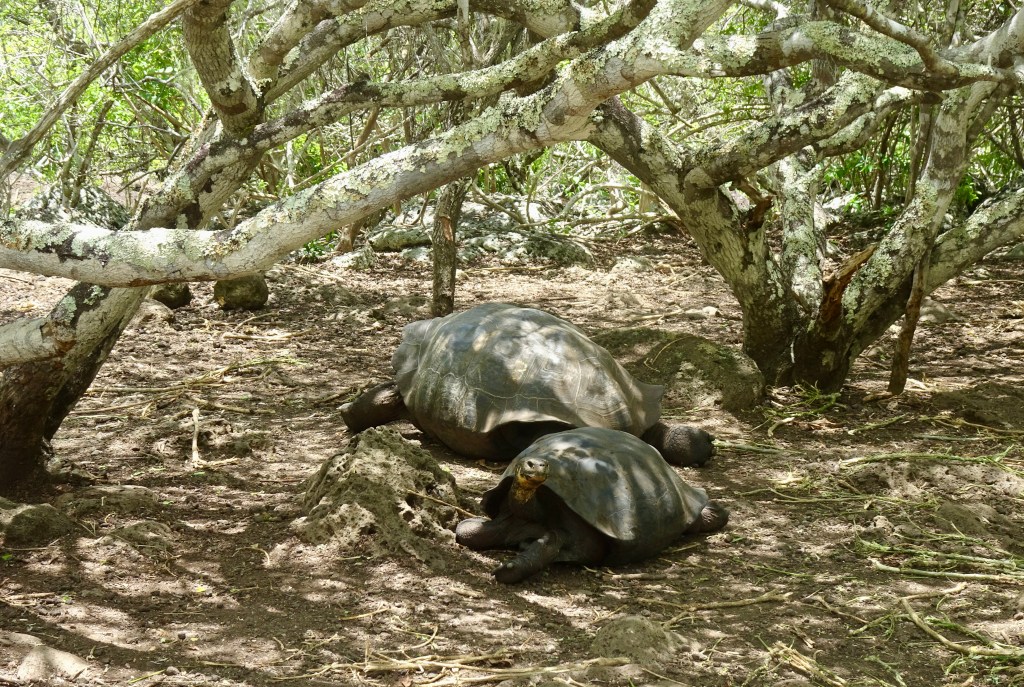
I will try to describe our experiences in this posting, and in the one following, I will give you our best advice about visiting Galapagos; what we loved, what we would have done differently, what we are sorry we missed, what to pack, how to cope with the intense heat and sun, how to book tours and how much this cost us.
Galapagos is a volcanic archipelago 1000 km. off the coast of Ecuador that consists of 13 main islands (three of them populated), and several rocky outcrops. It is situated on the equator and at the meeting point of several large oceanic currents, which helped create the unique life to be found there.
Darwin dropped by in 1835 and his discoveries forever changed our understanding of evolution. In 1959, 97% of the land mass was declared to be a national park and in 1979, Galapagos was declared a World Heritage Site by UNESCO.
We were in Galapagos for 10 days, split five days each between two islands. We decided against a boat cruise mainly due to their higher cost and shorter duration, so we researched land travel instead. One of our former students, Cesar, is from Galapagos and we booked our tours through Jeovanna, a friend of his who still lives on Santa Cruz, which was our first stop.
She arranged five tours for us, beginning with the Darwin Centre, the lava tunnels and the giant tortoises, led by the excellent and very knowledgeable Maria. She was our private guide for the day, which allowed us to pepper her with questions without annoying other group members.
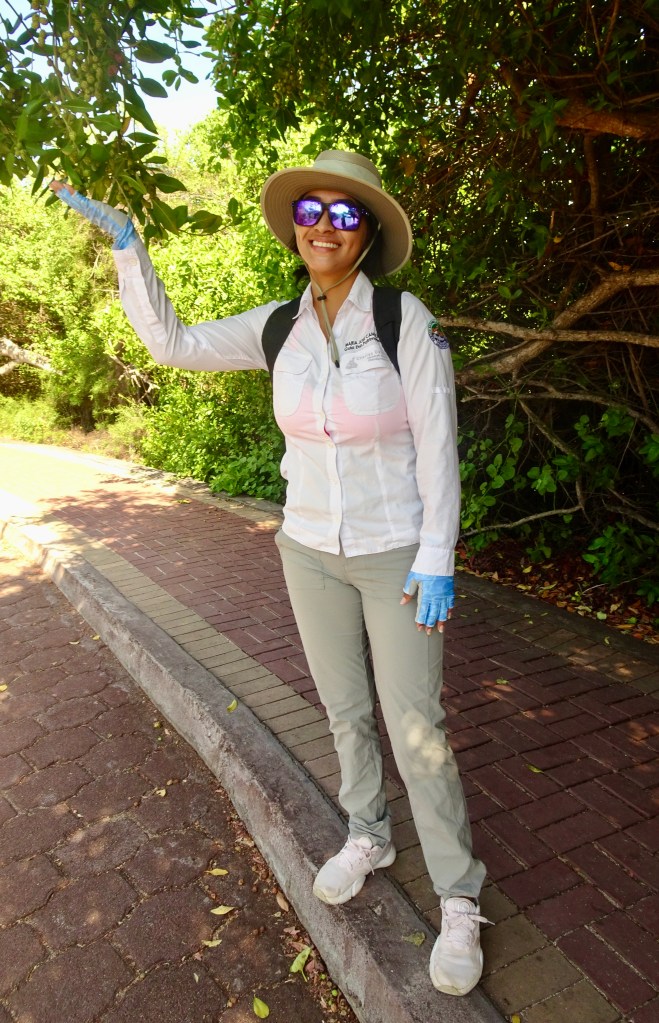
The Darwin Centre is located about 15 minutes from the entrance to the Foundation grounds, and although anyone can walk there independently, you require a guide to go through the tortoise breeding area.
Maria showed us several points of interest along the way. The Poison Apple tree is a favourite of the Giant Tortoises; their excreted remains help to spread the seeds throughout the islands. Humans, on the other hand, need to avoid this tree at all costs. They could die from ingesting the fruit and the sap could cause blindness, or at the very least a painful skin irritation.
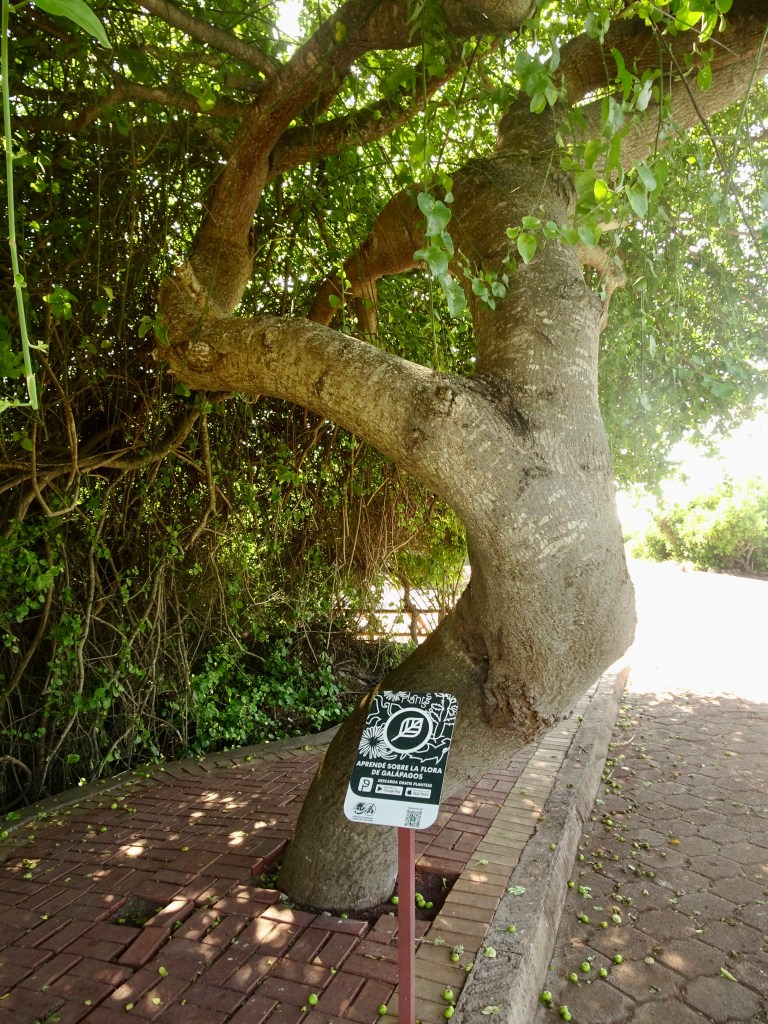
“Endemic”, “Natural” and “Introduced” are terms often used in Galapagos. Endemic refers to the species unique to the area, natural refers to a harmless evolution of species and introduced were animals brought by humans to Galapagos that upset the natural order of things. Examples of introduced species would be rats, goats, pigs, dogs, and cats – all of whom pose a threat to the young, thereby endangering many species.
The Marine Iguana are the only sea iguanas in the world. They live on sea algae and although they move at a leisurely clip on land, they are speedy and powerful swimmers.
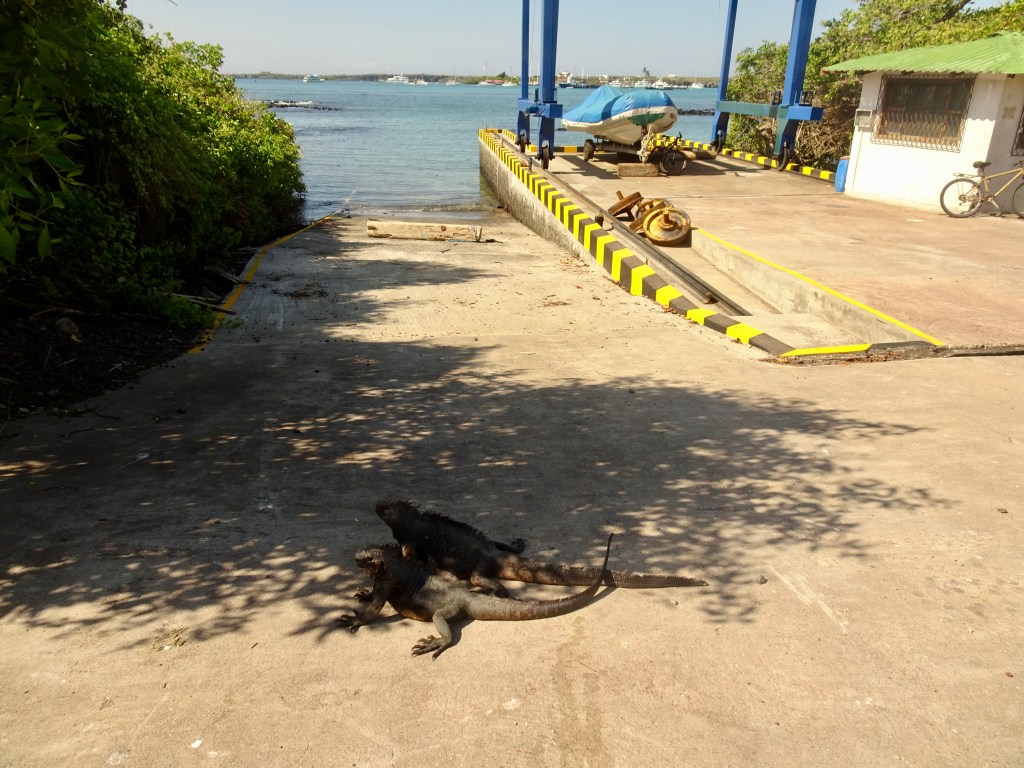
They tend to be black in colour, unless they are mating and then their hide turns red and green.
These two are obviously off-duty.
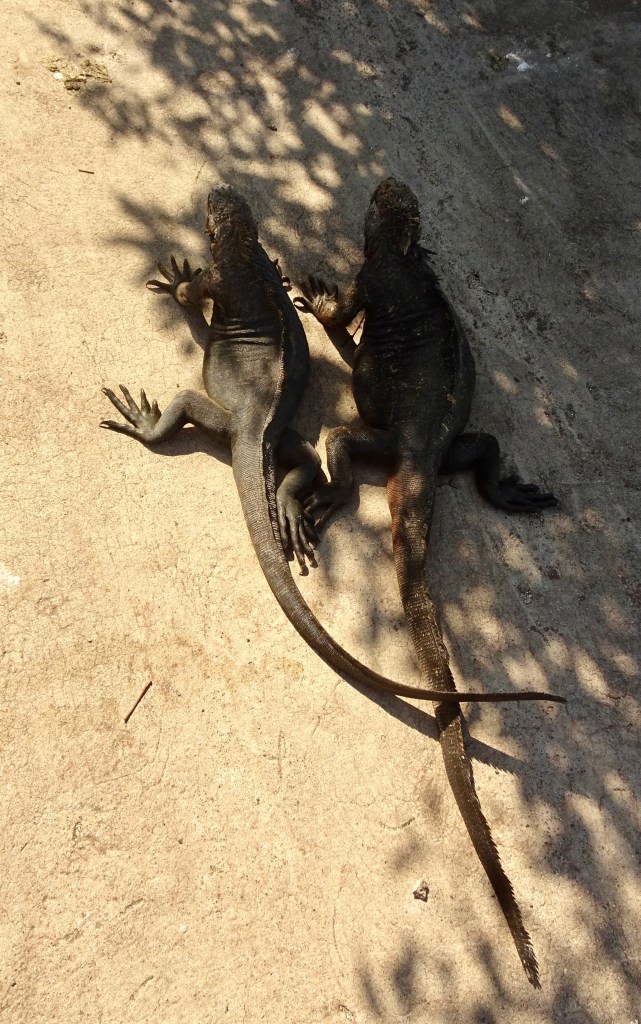
The Charles Darwin Foundation for Galapagos Islands in an international non-profit scientific organization. For over 60 years it has collaborated with the Galapagos National Park Directorate with ongoing research and protection efforts.
The Exhibition Hall is very well done, with photography, exhibits, films and information about the years of research. Plus, it is air-conditioned and they will stamp your passport, which is reason enough to visit.
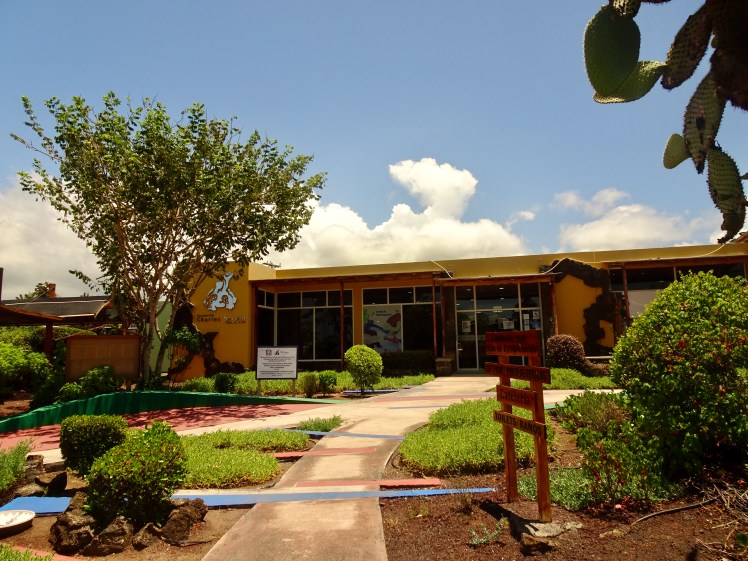
We met Lonesome George, who died in 2012 at over 100 years of age. He was the last surviving Pinta Island tortoise, but despite strenuous efforts to interest him in a mate and prolong the life of the species, he was either unwilling or uninterested.
His taxidermied body is mounted in a glass case; a rather eerie sepia-toned creature. I was more attracted to this rather wistful sign of Solitario George. Possibly George was not Lonesome at all, but simply wanted to live out his final years in peace.
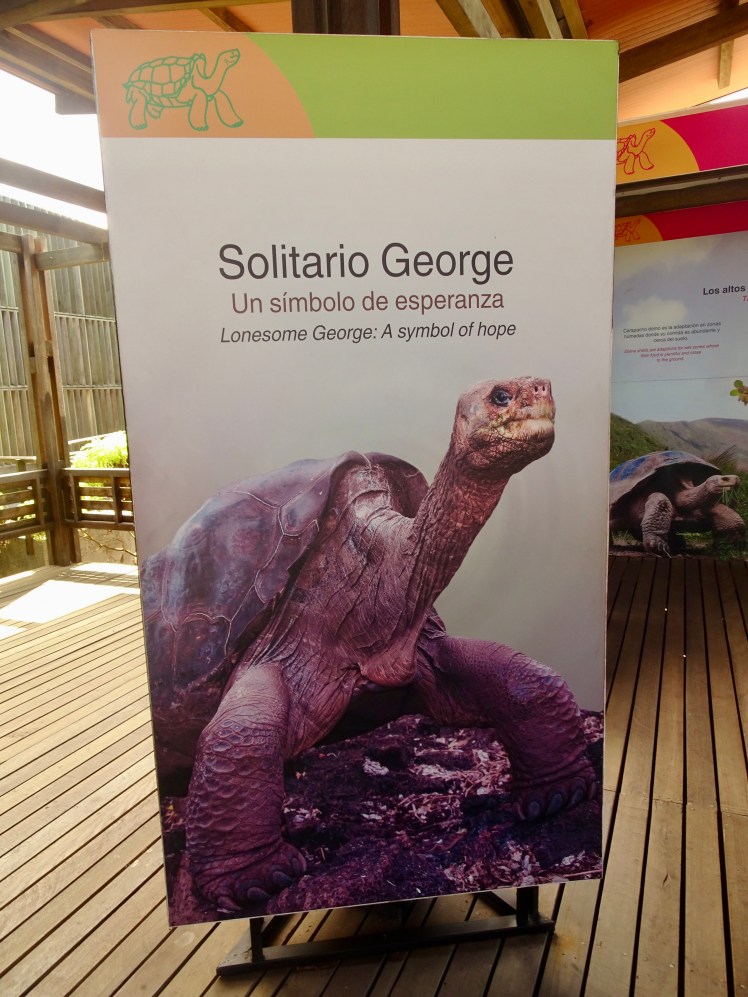
Maria showed us the tortoise babies – they are the size of your fist and will remain in their cage until they are about six months. At that time they are gradually moved until they are ready to be released into the wild without fear of predators.
Captive breeding has been successful – the breeding centres have raised more than 7000 tortoises. One species has grown from just 14 to over 1000.
I’ve enlarged the photo so you can see how well-defined the rings are on their shells.
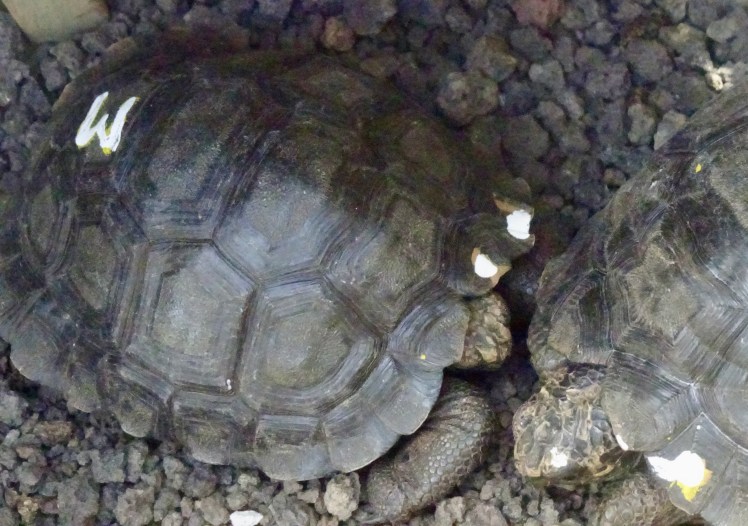
As tortoises age, these rings become less discernable. The age of tortoises can be determined by the smoothness of the shell – a tortoise of 100 years has wrinkle-free skin!
The two main shape of Giant Tortoise shells are saddleback and domed. This saddleback was sleeping quietly when Maria pointed him out – the domed tortoises are far more common.

And…the requisite “pose-beside-the-tortoise” shot. Although we were warned to keep the “Covid” distance – six feet.
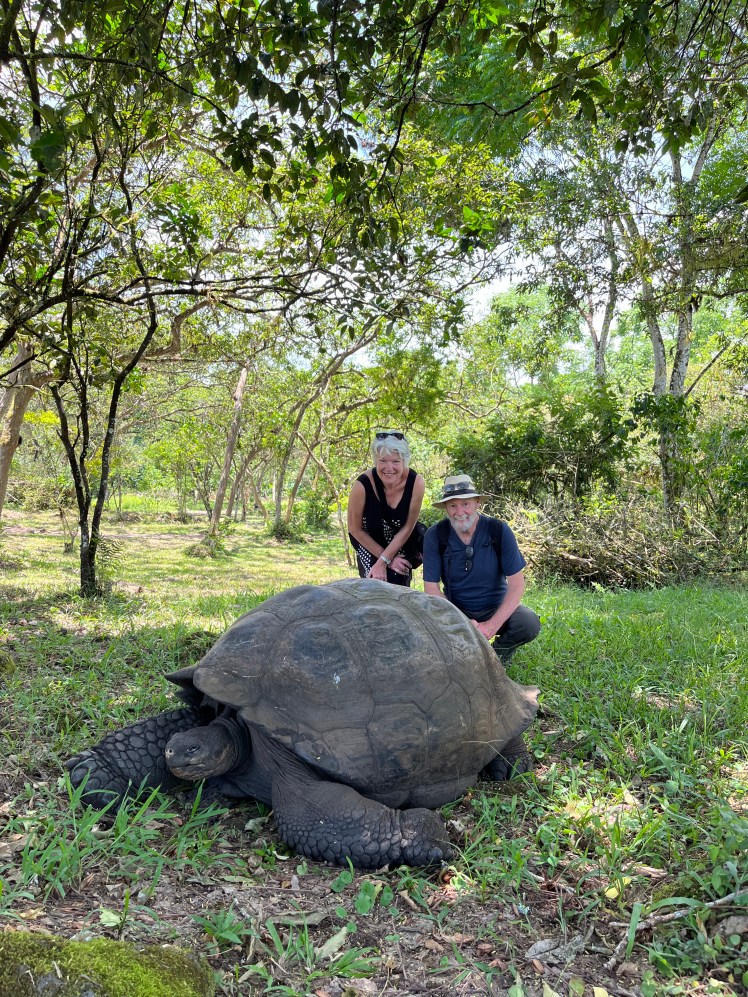
I might as well finish off the tortoise segment, although the following photos are from another tour.
There used to be over 250,000 tortoises, but whalers and pirates would take the tortoises on board their ships for food, as these animals can go up to one year without water. They now number 15,000 and while they are vulnerable, their future seems more secure.
Tortoises need to rest 16 hours a day to conserve enough energy to move. They alternate between being in the shade and lolling in these mucky ponds.

Tortoises reside in the highlands, which are cooler and have plenty of vegetation. With such lazy days and lots to eat, all that is missing is a love life. Tortoises are not monogamous, nor are they doting parents.
This is mating season, and we happened to catch a couple in the act. Our guide explained that the first thing you will hear is the call of the male – a long, drawn-out kind of wail. The female is silent and pinned down for the duration, which can take hours.
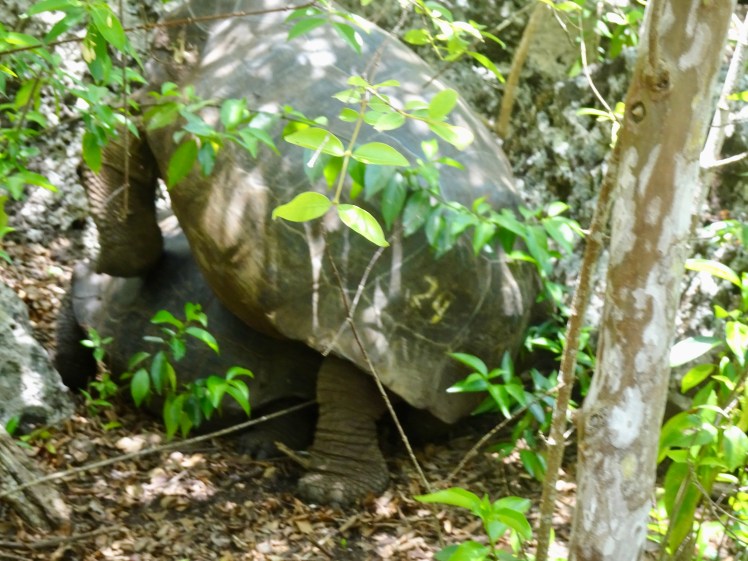
Once mating is completed, the female migrates to an area with dry sand, digs a hole and lays between 2 and16 eggs, and her work is done. They hatch after 130 days, and the brand new babies are on their own.
Next up on our tour were the lava tunnels. This one was 1 km. in length and was created during an eruption when the outer skin of the molten lava hardened and the liquid flowing through formed a cave. There are a number of “dry” ones on Santa Cruz and some more extensive lava tunnels on Isabela Island, which require swimming through in spots.
This one was relatively dry underfoot, and dimly lit, and mercifully cool.
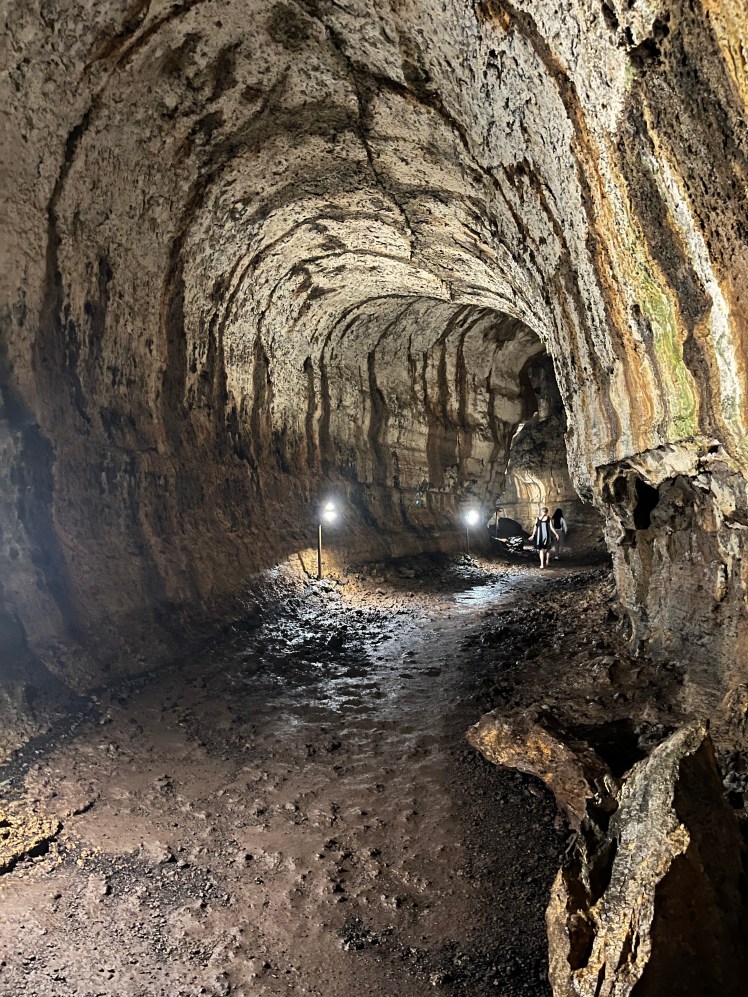
The next day was a full-on water tour to Bartolome Island, which began with a 45-minute cross-island bus trip to the channel, where we took turns taking the dinghy out to our boat.
We had a great little group of 14 people and our gregarious guide Mauricio. This was the inaugural sail of this tour boat and it set the bar for future excursions.

It took two hours to sail out on lovely calm sea and before we knew it, we had landed and were walking up a steep path – at times on boardwalk, at times just labouring up one step after another. I heard there were 300 steps, which may or may not be accurate, but it took a lot of sweat and effort to get there – in blazing sun and 90 degree heat.
This was our reward. This otherworldly landscape is an iconic Galapagos scene – the rock, sand, vegetation, clouds and sea.

From there we headed to another bay, and jumped in the water to snorkel for about an hour. The water was pure heaven, warm and crystal clear and we saw lots of fish, but none of the big ticket items. Not five minutes after we were back in the boat, we saw four or five penguins waddle over to the rocks, slide in and dart about in the water. We just missed them – or perhaps they were waiting for us to leave!
And that is the way of wildlife, of course. They are not there for our entertainment – we all just hope our timing is right.
Timing was perfect on the way back. We saw splashing on the horizon, then a few dolphins, then a few more and within a minute or two, our boat was surrounded. Our captain figured there were 100 or more. They jumped, they played, they dove and they leaped way up in the air – dolphin ballet.
Unfortunately, we were up top with the captain and my camera was down below, so you’ll just have to take my word for it – it was an incredible experience.
Another tour – off to Seymour Island, which is a dot just north of Santa Cruz and rich with bird life. Another terrific guide, Roland, or as he corrected me – Rrrroland. Galapagos guides go through rigorous training and are fluent in English – those jobs are coveted and well paid.
We hit the motherlode on this tour. Birds, both mating and nesting, were in abundance. The famous blue-footed booby was guarding her eggs. Rather than sitting on them to keep them warm, she was shading them to keep them cool.

Frigate birds were in the full throes of mating. The males develop a bright red pouch to attract females – not sure how it works and who gets the girl, but the island was filled with these rather agitated and swollen males.

These two were in a mating ritual of some sort, according to our guide.

The land iguanas were far more sedate. They are a dull yellow colour and blend in well with their environment.

Once we saw one, suddenly they were everywhere. I had the strongest desire to try and pet one of them, which of course is not only a bad idea, it could land me in a lot of trouble and cost me a lot of $$$.

It is possible to stay on three islands – Santa Cruz and San Cristobal, which both have ferry and airline service and Isabela Island, which is only accessible by boat. We chose to stay on the first two, flying into one and leaving from the other.
Santa Cruz’s town is much larger, busier and in a way, less attractive. San Cristobal is quiet and pretty, with its town circling a lovely harbour, and a malecon running the length. It also faces west, so the sunsets are an added bonus.
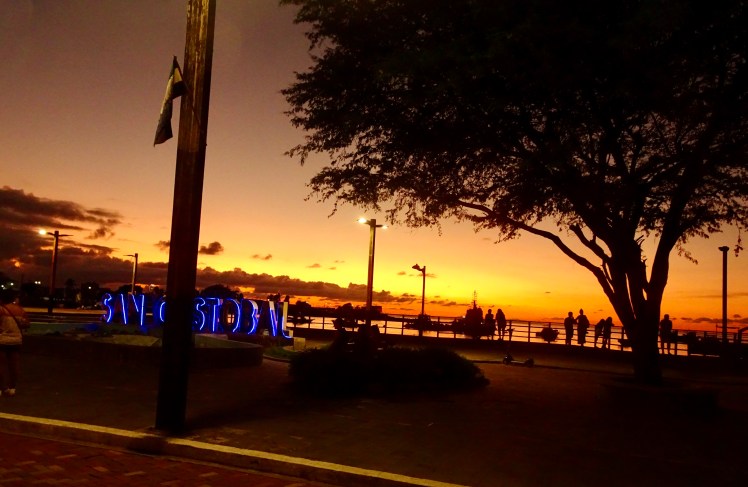
The big tour here is called the 360 tour – it follows the periphery of the island, and stops in three distinct places for snorkelling.
Now, the boats we had on our previous tours were lovely and clean and two level. You could sit up top with the captain, climb around to the front of the boat, sit in the back, or sit in air-conditioned comfort in the main deck.
This boat was much smaller, which was a bit of a surprise. What made the trip special for everyone was our group. We laughed and had fun and enjoyed the trip immensely as a result.
Our first stop – we swam into a lagoon to begin our snorkelling and at first the water was murky, but then it cleared and we saw sea turtles, which was a thrill. (this was not our boat, btw).

Another stop for swimming, which was out of necessity as much as a desire to swim, as the horseflies were simply brutal. The only escape was to submerge oneself in neck-deep water and stay there. At this point, we all swam about and chatted, while our guide stayed ashore.
Suddenly a frigate bird dove down to our belongings, picked up my sunglasses and then realizing they weren’t food, dropped them in the water. We found out that frigate birds (or pirate birds) are notorious thieves. Luckily our guide was there to run in and retrieve the stolen goods.
We had an unexpected stop for a “photo op” – a marriage proposal had been prearranged, and by the time it took place, we all knew about it, except for the bride. Our fellow travellers were our Bermuda couple, mum Nikki and daughter Aisling. A couple from Quito – Alejandro and Stefania. Two friends from Jersey – Bobby and Tito, and Tito’s long-distance girlfriend from Quito, Melanie.
We pulled into a quiet cove, where Tito led his girlfriend to the front of the boat for a photo, and with all of us watching, and his friend recording, he dropped to one knee and proposed. She cried and I cried, and thankfully she said yes. (Stephen teared up, too.)

After all that excitement, we barely had any energy for what would turn out to be the most challenging snorkel of the day. Kicker Rock is a formidable hunk in the open ocean, with strong currents, jellyfish, and the hope of swimming with hammerhead sharks.
It is best done earlier in the day, with a wetsuit and flippers and lots of energy.
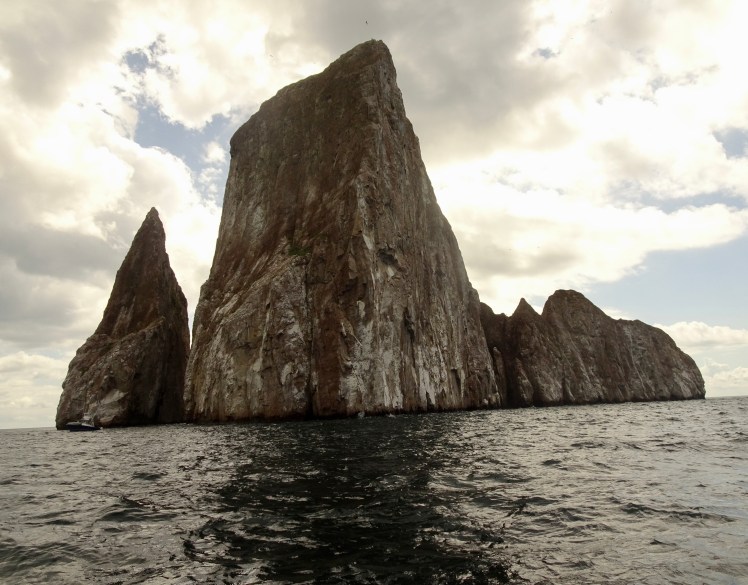
I was feeling apprehensive about leaping into deep water and landing on the snout of a shark, but told myself that my over-active imagination was at work again so I jumped. Without my flippers – which was a mistake. The current was quite bouncy and I couldn’t make any headway. I wasn’t seeing that much, but I kept feeling little stings.
The tide had brought in a school of tiny jellyfish, and between my fatigued floundering, waning courage and aggravating stings, I headed back for the boat. A couple of others joined me, and before too long, everyone had had enough. They did see a shark or two, but they were far below them.
Other people we talked to had swum with 20 or 30 sharks, just metres way from them.
That night, we all met to celebrate Tito and Mel’s engagement. We felt so honoured to have been a small part of it and having met all these folks made up for what was a less that stellar day.
Tito and Mel on the right.
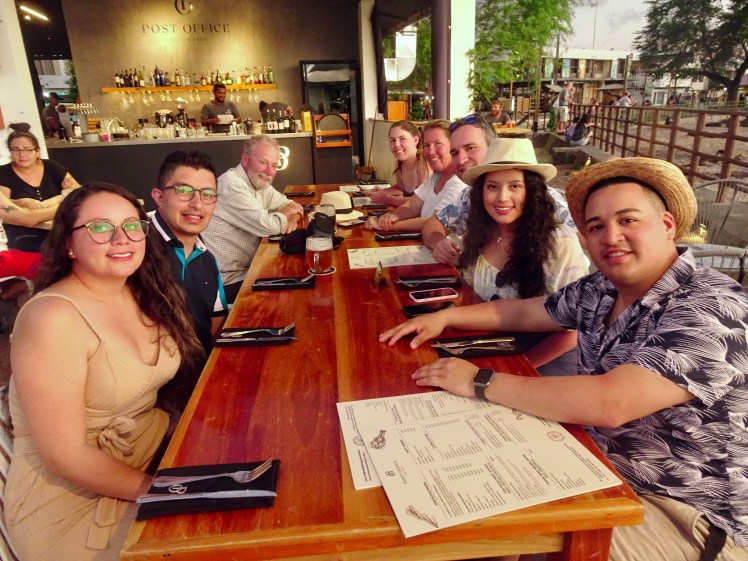
Our final tour was a private one with Wilson and his driver Jefferson. We don’t know if they were named after those two eminent presidents or if they chose those names for themselves.
We drove up into the highlands of San Cristobal and hiked around Junco Lagoon – a fresh water lagoon formed in an extinct volcano crater. The frigate birds come here to wash their wings and fly off again.

The landscape around the lagoon is simply beautiful – lush and green and a bit cooler than by the water.
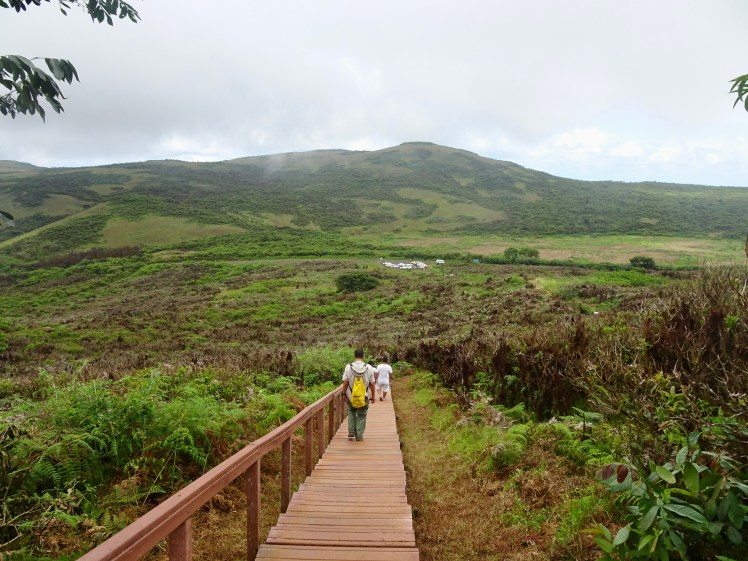
We also went to a tortoise breeding centre, and saw a number of giant tortoises that were just a little less “giant” than those on Santa Cruz.
San Cristobal has the largest colony of sea lions on Galapagos. They are completely unafraid of people, and while we were charmed by them, I was not comfortable being too close to them in the water. They are mainly friendly and playful, but the Alpha males can be unpredictable. They form a colony and take care of the whole group, so any perceived threat is aggressively dealt with.

Galapagos sea lions are smaller than other species; they could be mistaken for seals, although there are no seals at all on the islands. The males are 3-4 times larger than the females, and the babies are everywhere, often playing with their mothers.
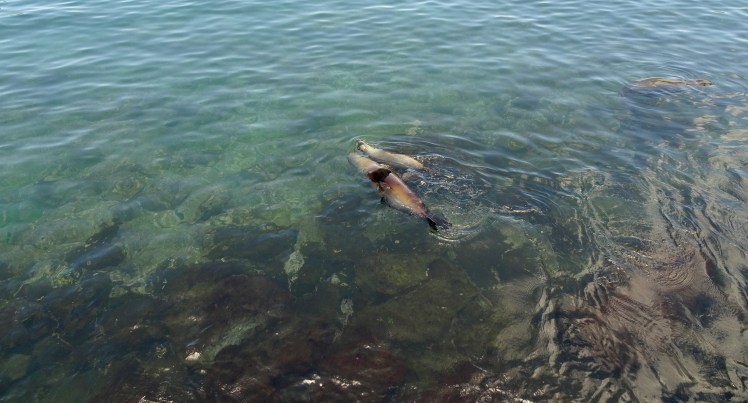
They get right of way in town too. You’ll see them on benches, or lying in the shade. People just learn to give up their seat or step aside.
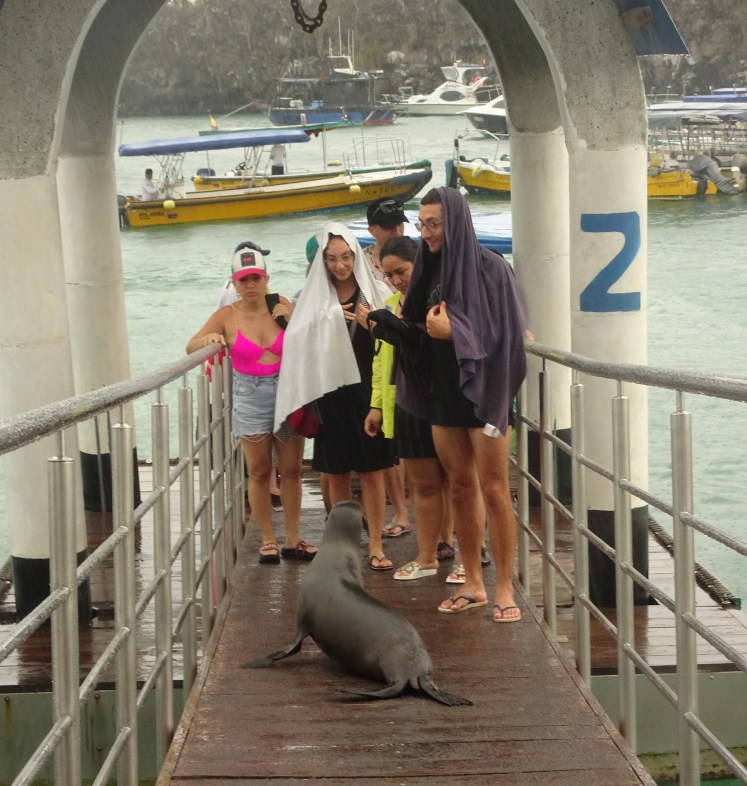
This fish market normally has an attentive sea lion waiting for scraps. The day we went by, the sea lion was sleeping it off in the corner, which allowed the pelicans and one marine iguana to move in.
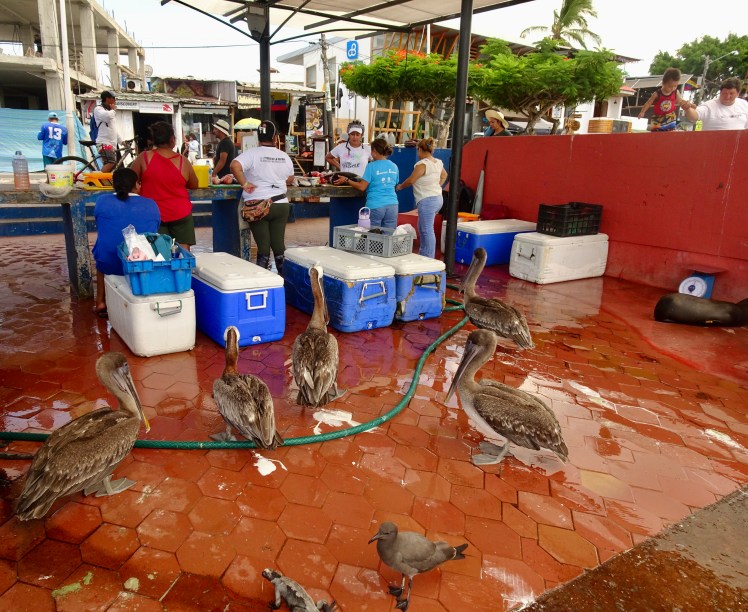
Our final snorkel today was at La Loberia beach. Not only did we see many schools of beautiful fish, but we swam with at least three sea turtles. At one point, I was just floating along, when a big shadow came into my peripheral vision. A massive sea turtle was just a foot or two away from me. He settled down to the ocean floor and I watched him for about 10 minutes. He didn’t do much, but he didn’t have to. It was a perfect last memory of Galapagos.
When you look at this unassuming small cove, (which is roped off because of the dangerous currents just beyond it), you would never guess to guess that such riches lie beneath.
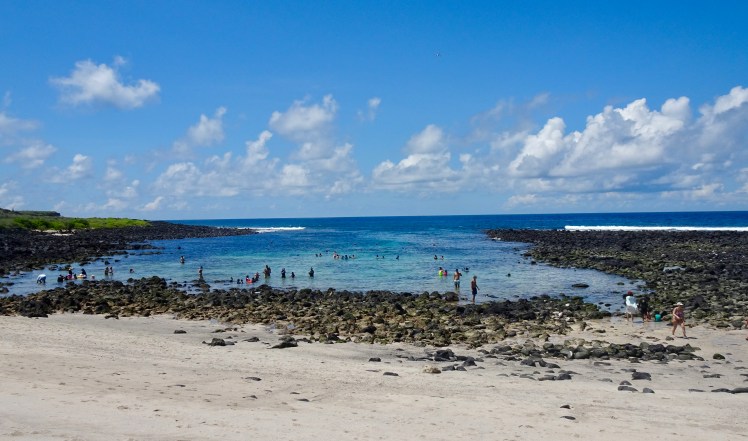
Oh, there is so much more to talk about, but it will take a long time to process everything we have seen and experienced. This was one of the highlights of our travels, without a doubt.
In a couple of days, I’ll put out a (short, I promise) recap of the nuts and bolts of this trip. Tomorrow we are enroute to Santiago, Chile.
awesome…as usual.
LikeLike
thanks Deb!
LikeLike
Fascinating! Thank you!
LikeLike
I’m still playing it all out in my head. It’s like nothing else.
LikeLike
Oh, Ginny, a glorious blog!! If we never make it to the Galapagos, we will always feel like we experienced a smidgen of this special place through your perceptive writing. Absolutely thrilled that this remarkable journey is rated as one of your travel highlights. Isn’t it wonderful how the world keeps sharing these unforgettable gifts through travel?
I am ready to grab the backpack right now!!!! Keep on truckin’…….
LikeLike
My dear friend – you and Gord are so ready to dust off those backpacks! And you are right – much like snorkelling, travelling peels back so many layers you don’t see from just looking at the surface. Never know what is around the corner.
LikeLike
Amazing, love your adventures
LikeLike
Thanks Annie!
LikeLike
Kicker Rock – my very first experience snorkeling. Terrified, yes. Exhilarating, yes. Sharks and rays, yes. Your pictures bring me back to last April. That sun is a killer, though, isn’t it?
LikeLike
Wow – I can’t believe that Kicker Rock was your first snorkelling experience – talk about going off the deep end. You started at the top and worked your way back – you can go anywhere now.
That sun is unbelievable. Ecuadorians know what to do – they cover up. Now I know why businesses close up in the middle of the day.
LikeLike
Looks like a place pretty close to heaven. Thanks for sharing your adventure.
LikeLike
It is pretty close to heaven, Patti. Galapagos is a pretty divine mix of science and religion.
LikeLike
What an amazing experience…thank you for sharing…
LikeLike
Di – I’m happy you enjoyed it. How was your time in Cozumel…or are you still there?
LikeLike
Having a great time and yes still here…for 12 more days…enjoy your journey!
LikeLike
Wow! Amazing trip. I loved reading about the tortoises. Ginny, you brought the islands alive for us. When we lived in Chile, we often thought of visiting the Galapagos but, unfortunately, we never made it. Thank you for bringing it to us.
LikeLike
Jeanne – it is one of those places – it just seems to capture people’s imaginations. When you think about it – you travel a long way to see lizards, iguanas, tortoises and sea lions. Some interesting trees. Most African countries offer up so much more diversity and drama, and yet Galapagos grabs us. Evolution!
LikeLike
The words are failing me ESTUPE NDO!!!
LikeLike
There are no words that do Galapagos justice, or even begin to describe it, but ESTUPENDO works well!
LikeLike
Amazing adventure.
LikeLike
It was amazing, Joy. It is right up there with our very best travel experiences.
LikeLike
A wonderful post. Thank you for sharing your adventures (and knowledge) with us. The text and images are so vivid that I feel vicarious thrills (and even “mehs”) when you do!
LikeLike
Thanks Shelagh! You expect a place like Galapagos to be nothing but mind-blowing, (and it mainly is), but to be “meh” is to be human.
LikeLike
I found this post fascinating. I’ve often wondered about Galápagos Islands. You’ve filled in lots of the gaps for me. I can see now why so many people are drawn to visit the Islands. Thanks for taking us along with you and sharing your enthusiasm for the place with us!
LikeLike
I had always thought of Galapagos as being somehow off-limits – one of those break-the-bank destinations. It is actually far more accessible, and there were so many young backpackers as well.
Who knows – we may even get back there again one day.
LikeLike
Fascinating – Galapagos must be one of the few places on Earth where humans and animals can mix so freely without being concerned that the other is a predator – don’t move too quickly and don’t get too close, and everyone is fine. What an amazing opportunity!
LikeLike
That’s so true Mike. I can’t think of any other place where this is possible. And the funny thing is that after a while you don’t even see them any more. We were waiting in line to register for the ferry from Santa Cruz to San Cristobal, and when we got to the counter, I realized my foot was just inches away from a sleeping sea lion.
LikeLike
Hi Ginny & Steve, Now you understand how I was about to put my foot on the lava while getting out of the Zodiac and realized I was about to put my foot on a marine iguana !!! You brought back memories of our time there. We had 15 people & I Naturalist per Zodiac and went out 15 min. apart so felt we were always on a small tour the whole time. It is an amazing place like no other part of the world we visited. I look forward to hearing more from you. I took pictures of Lonesome George when he was alive. Poor old guy ! Love Lyn
LikeLike
I was quite fascinated by their camouflage- such a natural evolution to be able to survive the harsh conditions there. Oh I think a good boat tour would have been amazing, since you can get to so many more places than when you do land tours.
Perhaps I am just anthropomorphizing here, but I can’t imagine they would have expected too much from a 100-year-old tortoise, especially since it appears to take hours, but it was worth a try.
LikeLike
Another wonderful post, Ginny! It’s the wonderful pictures that add so much to your stories. I’ll email after we get settled.
LikeLike
Looking forward to hearing how your trip is going.
LikeLike
Wow! What a trip of a life time. Lovely post Ginny. You both look amazing beside that big ‘ol tortoise, too! All the best, Sue xo
LikeLike
Thanks Sue – great to hear from you! I have vivid memories of photos you took during your trip to Africa and how undescribable that was – I think places like Galapagos and Africa are like that – you feel so lucky to have experienced it.
LikeLike